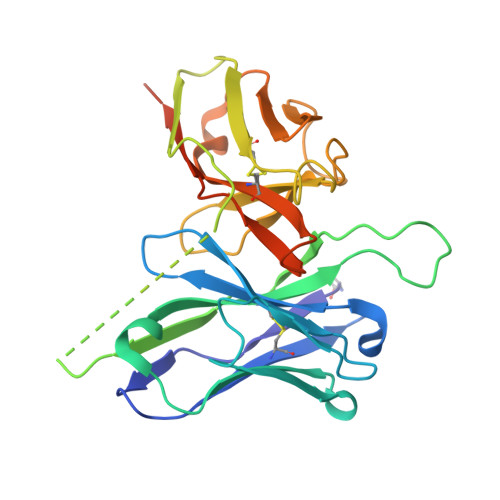Human Ige Against the Major Allergen Bet V 1 - Defining an Epitope with Limited Cross-Reactivity between Different Pr-10 Family Proteins
Levin, M., Davies, A.M., Lilljekvist, M., Carlsson, F., Gould, H.J., Sutton, B.J., Ohlin, M.(2014) Clin Exp Allergy 44: 288
- PubMed: 24447087
- DOI: https://doi.org/10.1111/cea.12230
- Primary Citation of Related Structures:
4BUH - PubMed Abstract:
The interaction between IgE and allergen is a key event at the initiation of an allergic response, and its characteristics have substantial effects on the clinical manifestation. Despite this, the molecular details of the interaction between human IgE and the major birch allergen Bet v 1, one of the most potent tree allergens, still remain poorly investigated. To isolate Bet v 1-specific human monoclonal IgE and characterize their interaction with the allergen. Recombinant human IgE were isolated from a combinatorial antibody fragment library and their interaction with Bet v 1 assessed using various immunological assays. The structure of one such IgE in the single-chain fragment variable format was determined using X-ray crystallography. We present four novel Bet v 1-specific IgE, for one of which we solve the structure, all with their genetic origin in the IGHV5 germline gene, and demonstrate that they target two non-overlapping epitopes on the surface of Bet v 1, thereby fulfilling the basic criteria for FcεRI cross-linkage. We further define these epitopes and for one epitope pinpoint single amino acid residues important for the interaction with human IgE. This provides a potential explanation, at the molecular level, for the differences in recognition of isoforms of Bet v 1 and other allergens in the PR-10 protein family displayed by IgE targeting this epitope. Finally, we present the first high-resolution structure of a human allergen-specific IgE fragment in the single-chain fragment variable (scFv) format. We here display the usefulness of allergen-specific human monoclonal IgE as a tool in studies of the crucial molecular interaction taking place at the initiation of an allergic response. Such studies may aid us in development of better diagnostic tools and guide us in the development of new therapeutic compounds.
Organizational Affiliation:
Department of Immunotechnology, Lund University, Lund, Sweden.

















